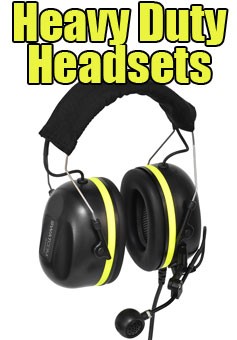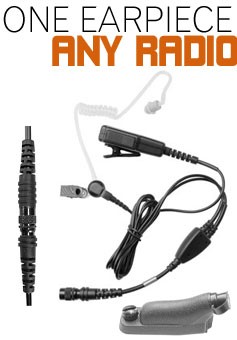
Earpieces with microphones have long been an integral part of covert communication devices and have a myriad of uses in day-to-day occupations that require discreet and hands-free operation. Most notably, they're used in conjunction with two-way radios, where one wire leads to a speaker that is placed inside the user's ear, allowing them to listen to incoming communications without the need for everyone else to hear.
The other wire terminates with a microphone, often combined with a push-to-talk (PTT) button, for transmitting the user's voice, ensuring that communication is secure and efficient. However, understanding the nuances of these devices is crucial for choosing the right one to suit your needs. In this comprehensive guide, we will walk you through everything you need to know about earpieces with microphones for radio communication.
What Is an Earpiece with Mic and Why Would You Use One?
Earpieces with microphones are small, sophisticated communication devices worn in the ear. They are more than a simple convenience; for many professionals and enthusiasts, they are an essential tool for maintaining radio communications without the need to handle a bulky radio handset.
This hands-free capability is invaluable in environments where clear, covert, or constant communication is a must. Interestingly, it’s not just the professionals who benefit—enthusiasts of activities such as running, fishing, or cycling use these devices to stay connected without impeding their movements.
The Anatomy of an Earpiece with Mic
Before we explore the various types of earpieces with microphones, it's important to understand their general structure. The device typically consists of a speaker, a cable, and a microphone. The speaker is the part that fits inside the ear; it delivers the incoming messages.
The cable can be singular, double, or triple, depending on the type of setup. Finally, the microphone is used to transmit the user's voice.
What is a Push-to-Talk (PTT)?
A Push-to-Talk (PTT) button is an important consideration when choosing an earpiece with a microphone. It is a control device that is used to switch from voice or audio transmit mode to receive mode. PTT ensures that communication is not only private but is also only active when the user intends it to be.
The Microphone on the Earpiece
The microphone on an earpiece is a small, usually concealed piece that picks up the user's voice. It could be designed to be clipped onto a lapel or sleeve for easier access and better voice transmission. The design and placement of the microphone can significantly influence the clarity of communication, especially in noisy environments.
Listen-Only vs. Listen-With-Talk Earpieces
Earpieces with microphones come in two primary configurations: listen-only and listen-with-talk.
Listen-Only Earpieces
A listen-only earpiece is just what it sounds like—it's a device that allows you to listen to incoming audio without providing a communication response. They are often used where discretion and the ability to hear without distraction are key, such as in event security or surveillance operations. Listen-only earpieces typically have a 3.5mm or a 2.5mm jack and can be connected to any transmitter that accommodates these connectors.
Listen-With-Talk Earpieces
Earpieces that fall under the listen-with-talk category enable both listening and transmitting. This dual functionality is crucial for maintaining a conversation without the need to physically interact with the communication device. There are several subtypes within the listen-with-talk category based on the complexity of the setup.
1-Wire Kits
A 1-wire kit combines the speaker and microphone into a single cable. The integrated microphone is located along the cable, and users trigger transmission using an in-line PTT button. These kits are relatively simple and are often the most discreet option for communication.
2-Wire Kits
In 2-wire kits, the speaker and microphone are separate wires until they reach the final connector that interfaces with the radio. This design allows for a more flexible setup, as the microphone can be clipped onto clothing for better voice projection and the speaker can be placed directly in the ear.
3-Wire Kits
The most advanced option is the 3-wire kit, which divides the microphone, speaker, and transmission components into individual wires. The primary advantage of this setup is enhanced clarity and discretion, as the user can position the components for optimal functionality. This kit is often favored in high-stakes scenarios, where the ability to fine-tune communication without drawing attention is critical.
Choosing the Right Earpiece for Your Needs
When selecting an earpiece with a microphone for radio communication, there are several factors to consider to ensure it meets your specific requirements.
Compatibility with Your Device
The first and most crucial factor to consider when choosing an earpiece is compatibility. Ensuring that the earpiece is compatible with your specific radio model is essential for reliable communication.
Comfort and Discretion
Earpieces are typically worn for extended periods, so comfort is essential. The design of the earpiece should be non-intrusive and should fit securely. For a more covert operation, select a design that can be discreetly concealed.
Environment
The working environment can significantly impact the choice of earpiece. For noisy environments, selecting an earpiece with noise-cancelling technology is advisable. In contrast, for quieter settings, clarity of audio and discretion may be more important.
Durability
The durability of the earpiece is also an important consideration, especially for professionals who work in rugged or challenging environments. Look for earpieces with reinforced cables and water-resistant features if you expect to be using the device in harsh conditions.
The Benefits of Using an Earpiece with Mic
The benefits of using an earpiece with a microphone extend beyond simple communication enhancement. They provide a range of advantages, such as:
- Hands-free operation, which is convenient and allows for multi-tasking.
- Improved privacy and security, as conversations are not broadcast over loudspeakers.
- Better hygiene, as personal communication devices are not shared.
- Enhanced focus, since the user's ears are the only recipient of incoming messages, reducing distractions.
Common Misconceptions and Tips for Using an Earpiece
Despite their many advantages, there are common misconceptions and best practices to keep in mind when using an earpiece with a microphone.
Misconceptions
One common misunderstanding is that earpieces with microphones are inappropriate for all but the most covert operations. In reality, they are extremely versatile and can be valuable assets in a variety of settings.
Usage Tips
Proper usage is critical for getting the most out of your earpiece. Users should ensure that the microphone is placed correctly for optimal transmission and that the earpiece is properly fitted and comfortable for extended use.
Final Thoughts
An earpiece with a microphone for radio communication is more than just a personal gadget or an optional accessory. It is a functional tool that can greatly enhance the effectiveness and safety of professionals in various fields. By understanding the different types, the necessity of a PTT, and the benefits they offer, users can make an informed decision when it comes to choosing the right device for their needs. Whether it's for daily work communication, security details, or keeping in touch during recreational activities, a well-chosen earpiece with a microphone can make all the difference in how effectively you're able to connect.


























